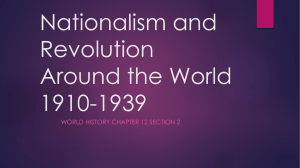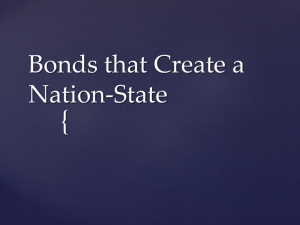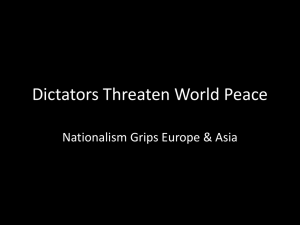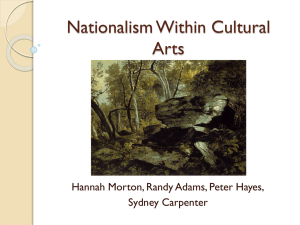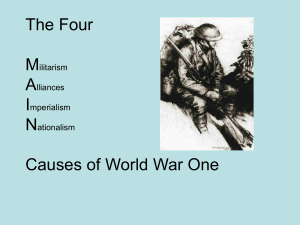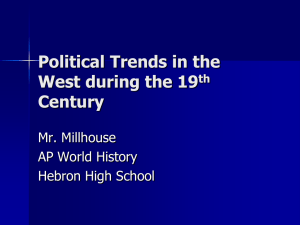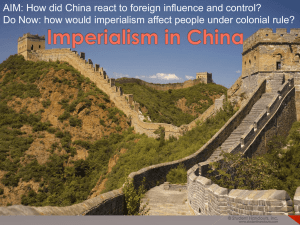PowerPoint 3-1 - Lincoln School
advertisement
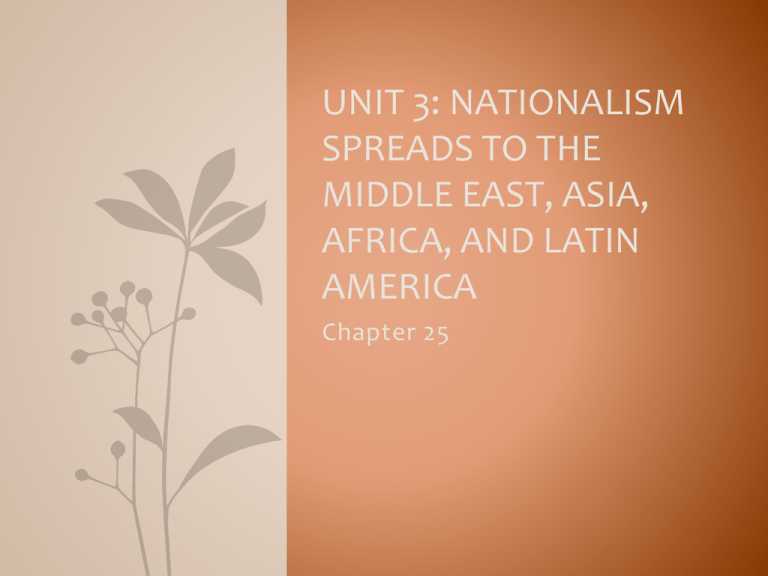
UNIT 3: NATIONALISM SPREADS TO THE MIDDLE EAST, ASIA, AFRICA, AND LATIN AMERICA Chapter 25 Essential Questions • What causes people to develop feelings of nationalism? • Is seeking divisions/enemies/others an inevitable part of human nature? • Is it possible for humans to define who they are without comparing themselves to who they are not? • What are the pros and cons of nationalism? • What are the modern-day implications of decisions made during this time period around the world? Ottoman Empire During WWI • Background • Ottoman Empire founded in the 1300’s • At its height controlled most of the Middle East, North Africa, large parts of Europe • By WWI much weaker, “Sick man of Europe” • Sided with the Germans/Central Powers in WWI, was defeated by the Allies • Nationalism in the Ottoman Empire Before/During WWI • Nationalism appealed to a small elite (ex. Young Turks) but not to most people before WWI • During WWI, extreme nationalists took control of Ottoman Government • Ottoman Empire was culturally and ethnically very diverse, lots of religions, lots of ethnic minorities, why would that be a problem for ultranationalists? • Result: Armenian Genocide, 1 to 1.5 million people killed Decline of Ottoman Empire Ottoman Empire becomes Turkish Republic • Treaty of Sevres • Treaty signed by Turkey after the end of WWI (Turkey’s version of the Versailles Treaty) • Turkey lost all its possessions in the Middle East • Allied countries occupied large chunks of Turkey • Britain/France—southeast corner • Greece—western coast • Italy—southwestern coast • International Zone—northwest corner • Ottoman Sultan unable to do anything to repel the foreign invaders • Sultan overthrown by the military, Mustafa Kemal • Mustafa Kemal pushed all foreigners off of Turkish land • Republic of Turkey established, Mustafa Kemal became first president Modern Turkey under Ataturk • Modernizing Turkey: Mustafa Kemal wanted Turkey to become more like the West • • • • Last names: Mustafa Kemal Ataturk (father of the Turks) Arabic alphabet replaced with Roman alphabet 5 year plan to encourage industrialization Secularization: outward signs of religion banned (no veils for women), religious toleration instituted • Western styles of dress: no fez hats for men • Education: free public school established • Women’s rights: legal equality for women, women encouraged to go to school and work outside the home, voting rights for women (1934) Ataturk Introducing the New Alphabet to a Turkish Village Ataturk’s Legacy Today • Ataturk’s ideas still are very influential in Turkey • Nationalism • Secularism • Republicanism • Problem: Turkey was/is a very religious place, lots of people didn’t like Ataturk’s reforms • Ataturk hand-picked candidates for the Turkish Parliament, only his political party was allowed, all other political parties were banned • Since Ataturk’s death the military and the courts have seen themselves as the guardians of his legacy • Often elections would put very religious politicians into power, who wanted to dismantle some of Ataturk’s reforms, the military would overthrow those elected politicians. (1960, 71, 80, 97) Is that right? • Since 2002 Turkey has become more democratic, the current Prime Minister has slowly allowed religion to become more prominent in Turkish society, is this good, bad, something else? • What caused the Turks to become nationalistic and rally around Ataturk? Nationalism in the Middle East: Syria, Iraq, Lebanon, Jordan, and Palestine • Ottoman Empire during WWI • British and French vs. Ottomans • War not going well for the British/French, needed the Arabs to join their side • Hussein-McMahon Correspondence • British ambassador (McMahon) promised the Sharif of Mecca (Hussein) that the British would support Arab independence if the Arabs revolted against the Ottoman Turks • Arabs joined the British • Fighting against the Ottoman Turks helped build Arab nationalism and desire for an independent Arab state after the war Things Get Messy: End of WWI • Contradictory Promises • Hussein-McMahon—British promised the Arabs independence • Balfour Declaration—British promised Jewish Zionists support for a Jewish homeland in Palestine • Sykes-Picot Agreement—British and French promised each other that they would divide and colonize the Middle East after WWI • Contradictions were settled at the Paris Peace Conference • Britain gained control of Mesopotamia (split into two and renamed Iraq and Trans-Jordan) as well as Palestine (open to Jewish immigration) • France gained control of Syria (split into Syria and Lebanon) • Arabs gained independence only in the territory around Mecca and Medina in the Arabian Peninsula (Hejaz) • Arabs tried to establish an independent state in Syria/Iraq but were forced out by the French military Sykes-Picot Agreement 1916 Eventual Partition of the Middle East Recap • Arabs Promised—Independent Arab state in the Middle East • Arabs Got • • • • • • Syria—French Mandate Lebanon—French Mandate Palestine—British Mandate, with Jewish migration Transjordan—British Mandate with Arab King (Abdullah I) Iraq—British Mandate with Arab King (Faisal) Hejaz—Independent Arab state with Arab King (Sharif Hussein) • Hejaz conquered by Ibn Saud, became part of Saudi Arabia 1930’s Problems In the Middle East • Arbitrary Borders • Britain/France drew lines on a map, didn’t correspond with who actually lived in those places • Different ethnic/religious groups lumped into the same country • • • • Ex. Kurds and Sunni and Shiite Arabs in Iraq Ex. Alawites, Sunni and Shiite Arabs, and Christians in Syria Ex. Christians, Druze, and Sunni and Shiite Arabs in Lebanon Ex. European Jews, Arab Jews, and Arab Muslims in Palestine Ethnic and Religious Composition of Iraq Ethnic and religious Composition of Syria Religious Composition of LLebanon Modern-Day Legacy in the Middle East • Palestine • • • • • Balfour Declaration=increased Jewish migration Plans to split Palestine into an Arab and Jewish state after WWII failed 1948 war broke out between Jewish and Arab Palestinians 1948 Jewish Palestinians won, Israel created Unresolved issues between Israelis and Palestinian Arabs till this day • Lebanon • • • • • Christian majority given most of the power by the French By 1980s Christians no longer a majority still had the majority of the power Civil war broke out in the 1980s Shiite militant group, Hezbollah, gained power Uneasy peace between Hezbollah, Christians, and Sunni Arabs today Modern-Day Legacy in the Middle East • Iraq • • • • King Faisal’s descendants overthrown Baath Party representing Sunni Arabs took control in the 1960’s Sunnis were a minority in Iraq Saddam Hussein, Sunni Baath Party member, became dictator, brutally repressed Kurdish and Shiite rebellions • After US invasion in 2003 Saddam overthrown, Shiites in power • Ethnic tension between Sunnis and Shiites still remains today • Syria • Military dictatorship took control in the 1960s • Civil War broke out in 2011 • Minority ethnic groups: Alawites, Shiites vs. Sunnis and Kurds • Jordan • Abdullah’s descendants still on the throne (Abdullah II) • Slowly making democratic reforms Nationalism in Africa • Nationalism in Africa = Desire For Independence • Factors that caused a rise in nationalism in Africa after WWI • • • • Africans sent to Europe to fight in WWI Woodrow Wilson’s 14 Points Tired of European Imperialism Young Africans educated in Europe coming back to Africa • Effect of Nationalism in Africa • Rise in desire for independence • Increase in rebellions against European rule • No independence (not until after WWII) Nationalism in Asia • French Indochina (Vietnam, Laos, Cambodia) • • • • • Wanted independence from France Ho Chi Minh = the leader of the Vietnamese movement for independence Vietnamese heavily influenced by communism, ideas of Lenin and the USSR No independence until after WWII Vietnamese defeated the French in 1954 gained independence • Japan • • • • 1920’s and 1930’s Japan was a liberal democracy Heavily industrialized economy Problems: Japan had a lot of people but not many natural resources Late 1920’s the economy began to decline many turned away from liberalism and towards militant nationalism • Nationalists saw the military as the solution to Japan’s economic problems Japanese Military and Extreme Nationalism • 1931 Invasion of Manchuria • Mukden Incident—Japanese military destroyed their own railroad in Chinese Manchuria • Japan gained control of Manchuria • 1937 Invasion of China • Japanese military blamed Chinese nationalists for attacking Japanese soldiers in Beijing • Japan responded by invading China • Japan vs. China 1937-1945 (end of WWII) • Military in Control • Military used the war in China as an excuse to take over total control of Japanese society, government, culture • Question: What explains the rise of the military/nationalism in Japan? Nationalism and Communism in China • Questions to think about: • What things caused nationalism in China in the early 1900s? • What happened to unity within the Chinese nationalist movement as time went on? • Background: China in the early 1900s • China was once the most powerful/advanced country in the world • During the late 1800s imperialized by European powers, “spheres of influence” • Chinese government lost control of most of the country to either European powers or local warlords who did whatever they wanted • Sun Yat-sen founded the Chinese Nationalist party to fight against European Imperialism and Chinese warlords • Paris Peace Conference: many in China hoped that the major powers would support Chinese independence, no more imperialism in China, that didn’t happen, led to a major upsurge in Chinese nationalism Nationalists and Communists in China • Chinese Nationalist Party • Led by Sun Yat-sen and Chiang Kai Shek • Mostly a middle and upper class movement, popular in cities • Wanted to make China an independent Republic (like the US or Great Britain) • Wanted to kick imperialists and Chinese warlords out of China • Chinese Communist • • • • Led by Mao Tse Tung (Mao Zedong) Mostly a lower class movement, popular in the countryside Wanted to make China an independent communist state (like USSR) Wanted to kick imperialists and Chinese warlords out of China • Nationalists and Communists wanted mostly the same things, so they united together in the early 1920s to achieve their shared goals Nationalists and Communist Success and Problems • Great Northern Expedition 1926-1928 • Nationalists and Communists recaptured most of China and defeated most warlords and took back large chunks of the country from foreign imperialist control • Nationalist-Communist Split • Chiang Kai-Shek distrusted the communists • 1927 Shanghai massacre, Kai-Shek killed most of the Communist leadership in Shanghai • Republic of China • Nationalist made a new Republic of China led by Chiang Kai-Shek • Problems • • • • Not very democratic Ignored the wishes of the poor, especially in the countryside Communists not totally defeated, still active in some parts of China Nationalist government was very weak, only barely controlled large parts of China Nationalist vs. Communist Civil War • The Long March 1934-1935 • Chiang Kai-Shek launched an expedition to finally destroy the Communists in 1934 • Mao Tse Tung fled from the Nationalists, 6,000 miles • Eventually reached safety outside of area controlled by Nationalists • WWII • Nationalists and Communists worked together from 1937 to 1945 to fight the Japanese • After WWII to Today • After WWII the Chinese communists were much stronger than the Nationalists • Civil War started up again, Communists won in 1949 • Mainland China became a communist country People’s Republic of China • Chiang Kai Shek and his Nationalist supports fled to the island of Taiwan and crated the Republic of China (Taiwan) China Today Nationalism In Central and South America • What were things like in Central and South America during the early 1900s? • Economically? • Politically? • Foreign countries had a lot of influence and control over Central and South American affairs—especially US • Examples (political): US military occupation of Haiti, Cuba, Nicaragua, Dominican Republic, etc. • Examples (economic): Central/South American economies dependent upon exports to make money, and on imports to supply themselves with industrial goods • What kind of feelings would political and economic dependence cause people in Central/South America to have toward the US and other European countries? How would this help cause feelings of nationalism? Nationalism in Central and South America • Great Depression • exposed problems with the economies of Central/South America, caused economic hardship • Led to calls for political and economic independence/self sufficiency • Good Neighbor Policy • US agreed not to use its military to invade other countries in Central/South America • Import Substitute Industrialization • Central/South American countries began to build their own industry so they wouldn’t have to import goods from abroad • Rise of populist political leaders • People began to support political leaders who looked out for the interests of the poor • Examples: Vargas in Brazil, Peron in Argentina, Cardenas in Mexico Nationalization of the Oil Industry in Mexico • Nationalization=when a government takes over privately owned property and makes it the property of the people of the country or nation • Mexican government expropriated (took over) foreign owned oil wells and refineries in Mexico 1938 • Why? • How an example of nationalism? Diego Rivera

